Centauri Dreams
Imagining and Planning Interstellar Exploration
Towards a Vessel Pattern Language
Today Heath Rezabek continues his investigation of the Vessel proposal, a strategy for preserving the cultural and biological heritage of our species. Based in Austin TX, librarian and futurist Rezabek is concerned with existential risk and ways to manage it. His work has yielded lively discussions in the comments section here, as has that of his collaborator Nick Nielsen, from whom we’ll hear tomorrow. In this essay, Heath moves on to question not only the various forms a Vessel might take, but where and how it could be built. Your thoughts are solicited not only in comments but also through the online survey whose address is given at the end. Previous essays in this series are Deep Time: The Nature of Existential Risk (on the mitigation of Xrisk through long-term archival and learning labs) and Visualizing Vessel (on visualization, design fiction, science fiction prototyping and their application to the Vessel proposal).
by Heath Rezabek

Comments and discussion in the previous installment of this series exploring the concept of Vessel habitats have yielded some unexpected and exciting developments. We have begun to flesh out an expanded conception of the Vessel proposal, in which the role of habitat and community is moved further to the fore, drawing on the ideal of a Vessel settlement as a haven — a word which means both refuge and port. If the Vessel is the core of material preserved, and a Haven is the community or habitat at which it rests, what does that haven look like? If actual ships some day departed from a Vessel Haven, as an exemplar colony of humankind dedicated to the cultivation of humanity (or even transhumanity’s) enduring heritage… What would that Haven be like?
The enthusiasm expressed regarding the possibility of building an interactive simulation or exploration game around the idea of exploring a Vessel installation has led the development team to begin exploring that very possibility, with Unity 3D as our current environment of interest.
In response to the insistent but welcomed critique that Vessel’s early visualizations were too abstract, remote, and alien, we have begun a deep exploration of visual patterns that more fully reflect humanity, and that tap into a more expressive and humane architectural language.
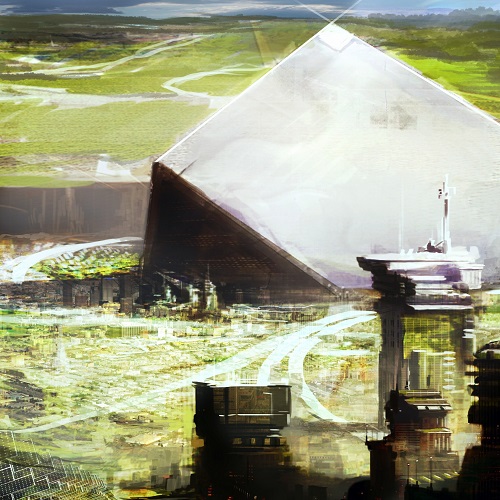
At this stage we are gathering examples that inspire us; some are from games, some from science-fiction or speculative art, some from works of real-world architecture. To peek in on this visual sounding board at any time, (or to submit images that you feel project and reflect a reaching-forth of our nature), feel free to check out http://vesselhaven.tumblr.com).
More on these developments in future installments.
Resilient Future Habitats and Long Term Archives: Towards a Vessel Pattern Language
One of the pivotal points in the development of the Vessel proposal was a re-reading of the section on The Future of Mankind in Peter Ulmschneider’s Intelligent Life in the Universe (p.169-204). My edition is older, and I had read this section before, but often key facets of a solution are not clearly visible before a supporting framework has been perceived.
In this section, Ulmschneider muses on our prospects over the near and long term, but it was his thoughts on the role of asteroids which most directly informed the Vessel proposal. He writes:
“While the moon and perhaps Mars are expected to play important roles in the human settlement of space, it is the much smaller asteroids with their huge mineral resources that will have by far the largest potential significance for the future of mankind. (p.175) … As the human mind opens up to the limitless possibilities and opportunities of living in space, a great diversification of human society can be envisioned. Unlike Earth, where limited resources together with economical and geographical factors do not permit the maintenance of in permeable boundaries between nations, space colonies could develop into fully self-sufficient statehoods, which might individually regulate their physical contact and communication with Earth and other space colonies, and thus develop their own independent cultures and ways of life. As a huge number of asteroids, moons, Kuiper belt objects, and comets awake exploitation, territorial behavior among these nations would be impractical, unnecessary, and unreasonable. Ultimately, this might lead to an unimaginable diversity of cultures and lifestyles of mankind. This cultural diversity, and the spread of mankind over the entire solar system, would be the best insurance against any fatal catastrophe in the future of rising from external and internal threats.” (p.187) [1]
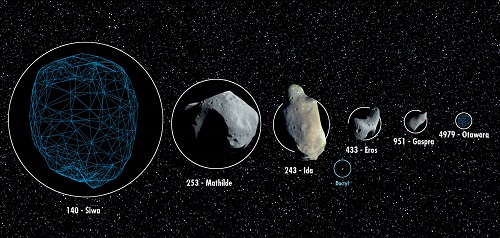
If an asteroid could be surrounded by a shell-like structure — perhaps a geodesic membrane, using the irregular mass of the asteroid to supply material for construction and infill to shape the mass towards roundness — then one could conceive of small worlds as a technical possibility.
The train of thought which led from asteroid-worlds to the Vessel proposal ran like this: Naturally, this kind of asteroforming (?) effort would take time, and time is not guaranteed. We have not yet solved the puzzles of closed-loop ecosystems. The moon is far closer, and its conditions closer to those on an asteroid than Earth’s are. Yet consider the Earth: even our most extreme locations would provide wonderfully forgiving environments for experiments in large-scale enclosure, with the added benefit of carving out limited spaces where we could strive more effectively to meet key challenges on Earth. And from there, the step to proposing archival and learning facilities such as Vessel habitats is a simple realization of priorities: Preserve what we have been and done so far, as an irreplaceable resource for the future and an inspiration for the present.
This train of thought yields multiple solutions to anticipated problems, and none of these solutions need be lost if they can be articulated. Let’s name some of these:
- Asteroid Enclosures (Though he did not focus on asteroids, thinking them too irregular in shape, at Starship Congress 2013 Ken Roy referred to this strategy as Shell Worlds.)
- Lunar Enclosures
- Earthbound Enclosures
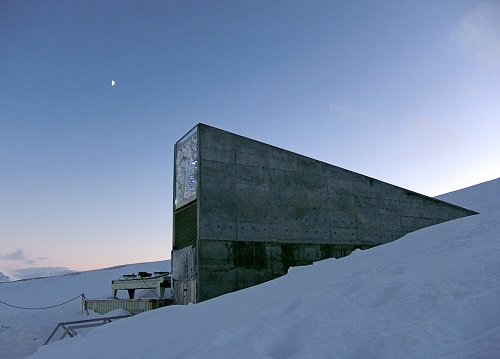
A theme arising through these approaches to Vessel habitat design is that of installation placement or positioning. Once we have determined to encourage the creation of many different instances as a strategy for resilience (each with its own unique qualities), it is a clear step to consider which sites would be ideal, or which sites would take priority if time were limited and placement were triaged. We have already mentioned the asteroid belt, and the moon, and our extreme environments — perhaps Antarctica, or a seaborne instance at the arctic circle. Some of these sites could be located by informed and determined seekers; others perhaps would be carefully hidden.
In correspondence, Lt. Col. Peter Garrettson recommended several potential positions, including the Lunar South Pole and the L5 Lagrange point. He also noted that having a Vessel facility housed within a solar power transmitting satellite in geosynchronous orbit, or positioned between two or more of them in an orbital array, could be a useful arrangement. This raises the possibility of any Vessel sited within a populated region to have at least one mirror directly above it, in GEO, providing it with supplemental power. Naturally, since the positions of these GEO Vessels would be clear, concealed mirror sites would also be needed.
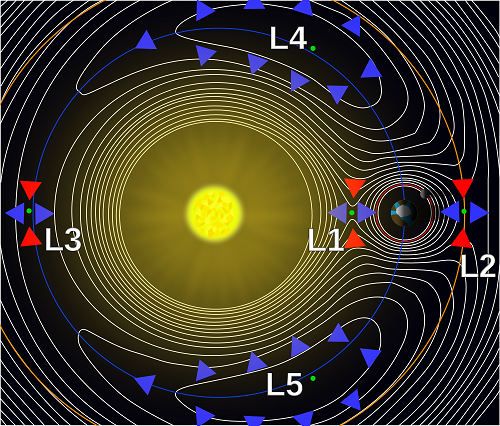
If we were to name some of these solutions, we might yield:
- Distributed Sites
- Redundant Positioning
…with subtypes including:
- L5 Point
- GEO Positioning
- Lunar Dark Side
- Lunar South Pole
… and so on.
Many more of these key positions could be envisioned. (In fact, as an exercise, we will try to do just that. See the end of this article for way to provide thoughts on where mission-critical caches of Earth-originating life’s traces might be placed.)
Another class of potential problem is that of power security. Designing a Vessel Haven or complex to operate independently of any surrounding infrastructure could help to mitigate risks to a Vessel Haven from large-scale solar events or other unforeseen circumstances. Dr. Daniel Sheehan, of USD, notes in correspondence the many ways that hardening a Vessel installation’s power system could be accomplished:
“If one has access to a space weather forecast, then vulnerable elements can be disconnected before a storm.” … “If the power grid is small, then the Faraday induction due to time changing magnetic fields can be minimized. If transformers and other devices have surge protection, this would add safety. If one got away from grid systems entirely and went with local power generation, e.g. small electric generators or, better yet, heat recyclers, then there should be no problem. Solar events are really only problematic for large-scale electrical grids. The bottom line: your Vessel installation could be easily hardened against flare events.”
We can name some of these strategies thusly:
- Independent Power Infrastructure
- Dedicated Power
- GEO Beamed Solar
- Forecasting Downtime
- Heat Cycling
Once a design solution is named and detailed such that it can be reapplied in novel ways, it can be called a Design Pattern. If all of these design patterns are developed to reinforce one-another, together they form what is called a Pattern Language.
These two concepts come to us from the fields of architecture, computer science, and design. Originating with an architectural pattern language expressed by Christopher Alexander in 1977 (see his book A Pattern Language), this approach requires that a design solution include a few key elements:
– A concise name or title which expresses clearly the design solution it strives to implement.
– The original problem statement or design challenge, articulated concisely beneath that title.
– Context, research and insights into the design challenge and the ways they suggest their solution.
– The full design pattern, articulated concisely.
– (Ideally) the design pattern is flanked by a listing of those larger patterns which help to shape it (at top), and those smaller patterns which it helps to shape (at bottom).
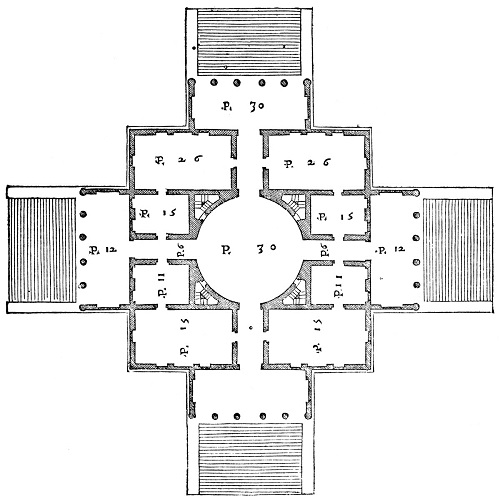
Developing a Unified Design Pattern Language for the Vessel project is one of our key goals for 2014. This pattern language will ideally span a range of disciplines, from architecture to systems design. Because the approach has been successfully applied across fields for decades, developing a cross-disciplinary pattern language for Vessel design should prove quite possible. If the virtual simulation of various Vessel Haven architectures proceeds well, these virtual spaces may become embodiments of the pattern language being built, like a living database that can be experienced also as an interactive space.
And, of course, all of these lessons should be applicable to other complex design tasks along the road towards an interstellar civilization.
Determining the core patterns which would help form a Vessel Haven is an ongoing process. As a first small test of crowd input, we present an opportunity to help explore one of these design factors: That of location.
An archive of Earth’s culture, science, and biodiversity could take many forms, but one question is that of where to position such facilities, and there are many possibilities. At the following link, you can help shape those design possibilities by submitting locales or positions which come to mind, while also prioritizing the existing ones as more or less preferable. Imagine that resources and motivation were no issue, and that the means existed right now to build a vast network of Vessel archives and havens. Where would they go and which would come first?
Examples of possible Vessel locales include Arctic Circle, L5, or Lunar South Pole. When listing locations in cities and populated areas, the assumption will always be that these are mirror facilities, not the sole versions of those facilities, for the sake of resilience. So, examples of populous locales might include New York (Mirror), London (Mirror), and Geneva (Mirror).
There are many more possibilities to be explored. Please give it a try! You may add as many ideas as you like, you may vote as many times as you wish, and the survey never ends: simply stop when you’re done, and feel free to [View Results] at any time:
http://www.allourideas.org/vessel-positioning-2013
As always, questions and comments are welcomed.
References
[1] Peter Ulmschneider, P. Intelligent Life in the Universe (Springer-Verlag, 2004).
[2] Alexander, C., Ishikawa, S. & Silverstein, M. “A Pattern Language: Towns, Buildings, Construction,” (CES Center for Environmental Structure) (Oxford University Press, 1977).
Looking Ahead to TESS
Thinking about the Kepler results now under discussion in these pages, one thing that stands out is that for most of the Kepler planets, we have no idea of their density. A transit can tell you about the size of the planet crossing in front of its star, but following up the detection with ground-based telescopes is crucial, because radial velocity studies can put some boundaries on its mass. With both size and mass in hand, you can determine the density, and that tells us whether a detected world is rocky like the Earth or a water world or an ice giant like Neptune.
In a recent interview with Popular Mechanics, David Latham (Harvard-Smithsonian Center for Astrophysics) described TESS, the Transiting Exoplanet Survey Satellite, and its role in the planet hunt beyond Kepler. With so many space observatories either cancelled (Space Interferometry Mission) or on indefinite hold (Terrestrial Planet Finder), it’s heartening to have this mission in the pipeline. And because TESS is going to be looking for planets transiting nearer, brighter stars than those available in the Kepler field — Kepler’s stars range from 600 to 3,000 light years from Earth — its targets will be easier to follow up with ground-based telescopes, so those all important mass measurements that lead to a planet’s density can be performed.
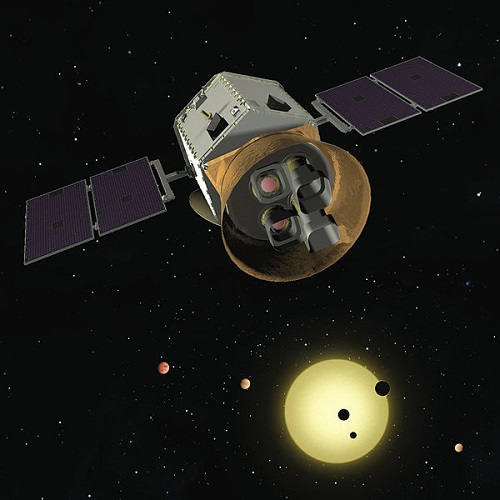
Image: An artist’s conception of the TESS mission, which will conduct an all-sky survey looking for transiting exoplanets. Credit: MIT Kavli Institute for Astrophysics & Space Research.
In a time of strapped budgets, Latham says the 100 man-years of work that went into the Kepler processing pipeline will be converted over to TESS, with much of the code re-used. The mission also gets an obvious boost from the experience Kepler has given us in processing vast amounts of data. TESS will be looking at the entire sky, making its field of view 400 times larger than Kepler, but it will spend about a month at a time on each location, with later follow-ups possible. Having identified the best candidate stars, TESS can turn the work over to space observatories like the James Webb Space Telescope or next generation instruments on the ground for the kind of deeper investigations that may one day characterize a small exoplanet’s atmosphere.
Think of TESS, then, as a spotter mission. In a backgrounder from the Kavli Institute for Astrophysics and Space Research (MIT), George Ricker discussed TESS’s role in finding targets that are suited for follow-up through optical and infrared telescopes. Ricker is interested in multi-planet systems that can be studied when one or more of the planets transit the host star. Their gravitational interactions cause slight changes by accelerating or decelerating these worlds in the course of their orbits, with even small planets that we can’t detect affecting the transit time of larger planets in the system. TESS should help here:
Measuring transit time variations is particularly important because if you find a large Neptune- or Saturn-sized planet that appears to be tugged a little bit, you can make an estimate of how massive the planet is that is actually doing the tugging. Measuring transit time variations, which is a technique enabled by Kepler data, is a bit like successively unnesting a Russian matryoshka doll – you go a few layers down and you can find smaller and smaller planets in the system. That’s one of the things that doing transit time variations, during the TESS mission, will enable us to do.
The TESS team calculates that their observatory could detect as many as 2700 planets, including perhaps hundreds of Earth-sized worlds. Ricker notes that while the passage of the Earth in front of the Sun as viewed from outside our Solar System would dim the light of our star by about 85 parts in a million, TESS will be sensitive to drops of roughly 40 parts in a million. The observatory will be studying approximately two million stars brighter than 12th magnitude, and that includes red dwarfs relatively near the Sun, targets to which the TESS researchers will be paying particular attention. Ricker again:
What we envision is that after two years we will complete a census of all the transiting extrasolar planets in the sky that have a period of less than about a month. This will be particularly valuable for studying the small M stars that are so abundant in our galaxy. We will have a good sample of planet periods extending out to about a year, and this will cover a wide variety of solar types – from stars that are hotter than the sun to stars that are a lot colder than the sun, and for which the habitable zones range from small distances from the stars to large distances from the stars.
All of that should be enough to provide the James Webb Space Telescope with plenty of targets, and offer a solid follow-up list to Earth-based observatories. Scheduled for launch in 2017, TESS was conceived from the ground up with the philosophy of using components from the commercial semiconductor industry that can be modified to work in space, with the CCDs onboard manufactured at MIT. Using components from the commercial sector rather than developing all instruments in-house keeps the costs down, achieving a launch slot for TESS when other missions have fallen victim to the budget ax. TESS is scheduled to fly in 2017 aboard an Orbital Sciences Pegasus XL rocket released from a Lockheed L-1011 aircraft.

Earth-Sized Planets in Habitable Zone Common
The widely circulated Kepler results, announced yesterday, tell us that over twenty percent of Sun-like stars in the Milky Way have Earth-sized planets in the habitable zone, where liquid water could exist on the surface. Work out the math and it turns out that the nearest Sun-like star with a planet like ours in the habitable zone is probably on the order of twelve light years away, an energizing thought for those of us who ponder future technology and interstellar probes. Imagine: One in five Sun-like stars with a planet the size of Earth in the zone where liquid water can exist.
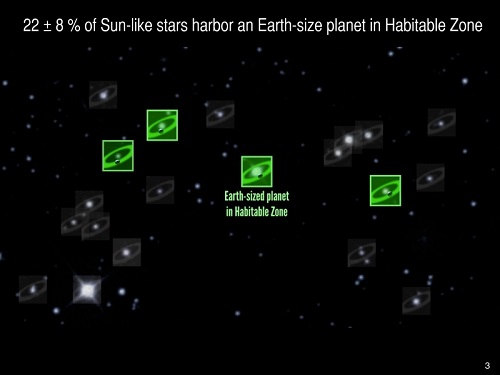
Image: Analysis of four years of precision measurements from Kepler shows that 22±8% of Sun-like stars have Earth-sized planets in the habitable zone. If these planets are as prevalent locally as they are in the Kepler field, then the distance to the nearest one is around 12 light-years.zone. Credit: Petigura/UC Berkeley, Howard/UH-Manoa, Marcy/UC Berkeley.
But how did we get here? Kepler, which was launched in 2009 to look for planets transiting their stars, examined over 150,000 stars for four years and turned up more than 3000 planet candidates. It’s been a fascinating ride, but finding ‘hot Jupiters’ and Neptune-class worlds and even intriguing super-Earths always reminded us that the primary goal was to learn what fraction of stars have Earth-sized planets at just the right temperatures for life. Ideally, retrieving data for G-class stars like the Sun would have helped us look for close twins of our planet.
Kepler’s malfunctions challenged but did not end that effort. The team involved in the present work includes Geoff Marcy and Erik Petigura (UC-Berkeley) and Andrew Howard (University of Hawaii, Manoa), who have been working with the 10-meter instruments at the Keck Observatory (Mauna Kea) to obtain data from the HIRES spectrograph, focusing on 42,000 stars in the Kepler field that are only slightly smaller and cooler than the Sun. 603 planets turned up, with 10 being between one and two Earths in diameter and orbiting in the habitable zone. Remember that only a small number of systems are oriented so that transits occur as viewed from Earth. The team’s algorithms yielded the estimate of 22 percent of all Sun-like stars with Earth-sized planets in their habitable zones, plus or minus eight percent depending on the habitable zone definition.
On the latter point, Erik Petigura defined the habitable zone for this study as that region where a planet receives between four times the light the Earth receives from the Sun and one-quarter of that amount. Kepler’s stuck reaction wheels have meant that extending the mission to analyze G-class stars like the Sun was not possible. Instead, the potentially habitable planets the team found in its survey all occur around K-class stars (Alpha Centauri B is the nearest example of a K-class star, though not in the Kepler field). The team’s analysis demonstrates that the results for K stars can be extrapolated to G-class stars, and thus we arrive at the 22 percent figure.
Telling us how common potentially habitable planets are around Sun-like stars is prime-time for Kepler, and now we have a reading that’s highly encouraging. As we look forward to missions to characterize exoplanet atmospheres and look for the signatures of life in their spectra, we can now assume that only a few dozen nearby stars will need to be observed before we detect an Earth-sized planet in the habitable zone, a fact that will play into the design of telescopes for such missions. Geoff Marcy, though, is quick to point out that just because a planet is Earth-like in size and in the habitable zone defined here, it isn’t necessarily life-bearing:
“Some may have thick atmospheres, making it so hot at the surface that DNA-like molecules would not survive. Others may have rocky surfaces that could harbor liquid water suitable for living organisms. We don’t know what range of planet types and their environments are suitable for life.”
The caution is understandable, and we are a long way from being able to make the kind of observations that help us pin down the presence of life on an exoplanet. We also need to remember that without information about the mass of these planets, we can’t say anything about their density and thus can’t be sure that they are in fact rocky worlds like our own. The discovery that Kepler-78b has the same density as the Earth, announced just last week, does tell us that at least some of these planets are likely to be rocky.
In any case, the idea that there are tens of billions of potentially habitable worlds in a galaxy of 200 billion stars is exhilarating, as Andrew Howard notes:
“It’s been nearly 20 years since the discovery of the first extrasolar planet around a normal star. Since then, we have learned that most stars have planets of some size orbiting them, and that Earth-size planets are relatively common in close-in orbits that are too hot for life. With this result, we’ve come home, in a sense, by showing that planets like our Earth are relatively common throughout the Milky Way Galaxy.”
We should also put these findings in a broader context. Red dwarf stars are not included in the study, but they represent 75 percent of the stars in the Milky Way. The question of whether life could exist around such a star, given the problems of tidal lock and stellar flare activity, is an open one, but we do know from previous work that 15 percent of these stars are expected to have Earth-sized planets in their own habitable zones (this is based on work by David Charbonneau and Courtney Dressing at the CfA; Ravi Kopparapu at Penn State obtained an even higher estimate). We don’t know yet whether life exists on any of the worlds around any of the stellar classes, but it does appear that the cosmos is stuffed with planets where the great natural experiments that lead to life can be run again and again.
The paper is Petigura et al., “Prevalence of Earth-size planets orbiting Sun-like stars,” Proceedings of the National Academy of Sciences, published online 4 November 2013 (abstract). Dennis Overbye’s report in the New York Times is well worth reading. I love this quote in Overbye’s article from Geoff Marcy: “This is the most important work I’ve ever been involved with. This is it. Are there inhabitable Earths out there? I’m feeling a little tingly.” Me too.

Views of Proxima Centauri
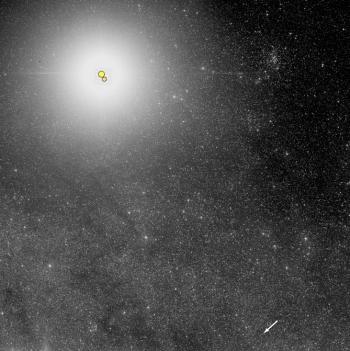
I haven’t yet read Stephen Baxter’s new novel Proxima, but because of my admiration for his previous books, it’s at the top of my reading list. Judging from the Amazon description, Proxima gets into issues that for me make red dwarfs utterly compelling. What would a habitable planet look like around such a star, tidally locked so that its sun never moved in the sky? What would it be like to move around this world, going from a warm substellar point toward twilight and then a frigid night on the dark side?
Given that this M-class red dwarf is 18,000 times fainter than the Sun, you wouldn’t expect it to make much of an impression in photographs. The one above (credit: European Southern Observatory) is instructive because it puts the entire Alpha Centauri system in context. At top left we have Centauri A and B, which are bright enough to merge together and appear as a single bright object. At the lower right is the arrow indicating Proxima Centauri, so faint as to be barely visible. Proxima is 4.218 light years from Earth and roughly 15,000 AU from Centauri A and B.
The image below gives us a brighter look. Taken by the Hubble Space Telescope, it isolates Proxima from the other two stars, but even here the red dwarf is a point-like object whose image is distorted by diffraction spikes produced within the telescope itself.
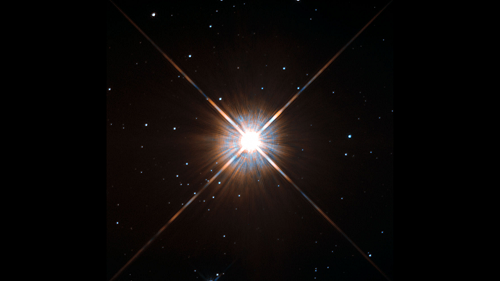
Image: The closest known star, Proxima Centauri is here imaged by the Hubble instrument. Credit: ESA/Hubble & NASA.
Proxima should remain a main sequence star for another four trillion years, about 300 times the current age of the universe. The planet search here is inconclusive, but here’s what we’ve got so far: Work by Michael Endl (UT-Austin) and Martin Kürster (Max-Planck-Institut für Astronomie), using seven years of high precision radial velocity data from the UVES spectrograph at the European Southern Observatory, can identify no planet of Neptune mass or above out to about 1 AU from the star. No super-Earths larger than 8.5 Earth masses have been detected in orbits of less than 100 days.
As for the habitable zone where liquid water could exist on the surface of a planet, it is thought to be between 0.022 and 0.054 AU, which would produce orbits between 3.6 and 13.8 days. The Proxima investigations have yet to find anything here, but the most we can say is that super-Earths of 2-3 times the mass of the Earth in circular orbits have been ruled out. That still leaves a lot of possibilities to be investigated as we refine our techniques and apply them to this intriguing star. Radial velocity capability down to one Earth mass is getting closer here.
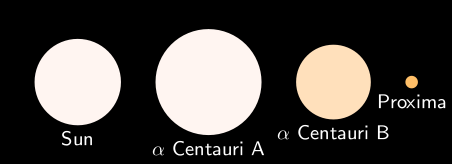
Image: Comparative sizes of the Alpha Centauri stars, with the Sun thrown in for comparison. Credit: Wikimedia Commons.
Because Proxima is a flare star that can experience sudden changes in brightness, any life evolving on a planet around it would have to have found a way to protect itself from such radiation. Even so, the star’s nearness to the Sun has made it a staple in science fiction, from Murrray Leinster’s 1935 story “Proxima Centauri”, published in Astounding Stories through Heinlein’s Orphans of the Sky (1963), where it was the logical destination for a starship, to the new Stephen Baxter novel. I’ll have more to say about the latter in upcoming posts. A search through the archives here will pull numerous articles on Proxima, including The Proxima Centauri Planet Hunt and Proxima Centauri: Looking at the Nearest Star.

Les Johnson: Big Projects and Deep Time
Not long ago I pulled a wonderful 1950 film out of my collection for a long-overdue viewing. I remember 711 Ocean Drive from late night television airings, and when it popped up a few years back on a local cable channel, I made a recording. Edmund O’Brien and Joanne Dru are the key players in this gritty tale about an electronics expert who gets drawn into big-time crime, and the ending, which takes place at the Hoover Dam straddling the Nevada/Arizona border, is simply terrific, with O’Brien taking the fall after his shady dealings have been exposed.

Image: On the run at the Hoover Dam in Joseph Newman’s 711 Ocean Drive.
Titanic forces, vast engineering, gunplay in the desert, all artfully directed by Joseph M. Newman — what more could you want? And now, thanks to Les Johnson, I connect Hoover Dam not only with a film noir classic but with long-term thinking and starflight. Johnson, speaking in his role as a science writer with deep connections to science fiction, told the recent Eve Online conference in Las Vegas that we as a species need to think big and think long if we are to realize our interstellar dreams. Hoover Dam was the example he used to remind us what it will take to reach the stars.
Deep Time and Future Engineering
I’m always looking for examples of long-term thinking in our history, because as a species, we actually do this pretty well. The Egyptian pyramids are an obvious example, and so are many European cathedrals, some of which were generational in their construction. Some cathedrals went up relatively quickly, to be sure — the main structure at Chartres took a mere 25 years. Others, like Lincoln or Notre-Dame in Paris, were a century or more in the making. The foundation stone at Cologne was laid in 1248 and by the time of the Reformation, the structure remained unfinished, to be completed only in 1880, having become a national project.
Johnson’s invocation of the Hoover Dam is a reminder that not all the great projects were undertaken by civilizations long gone. As a culture, we often seem to think in short time-frames, but we do have the engineering skills to do much better. This Discovery News story quotes Johnson as saying “this dam was built in the 1930s, but the design life of the dam itself (not the power systems) is 2,000 years … that’s foresight! That’s engineering planning. That’s something we shouldn’t be afraid of today when planning for our (species’) future.”
Johnson is well known in these pages not only because of his work at NASA’s Marshall Space Flight Center, but also for his non-NASA activities, which include writing and editing as well as frequent public appearances. Going Interstellar (Baen, 2012), which he edited with science fiction author Jack McDevitt, is a collection of fiction and non-fiction that belongs on your shelf if you share my passion for interstellar flight. And Solar Sails: A Novel Approach to Interplanetary Travel (Copernicus, 2007), which he wrote with Greg Matloff and Giovanni Vulpetti, is a wise introduction to the possibilities and the problems of building sails in space.
Methods like nuclear pulse (think Orion) and antimatter have their advantages, but all require us to carry fuel onboard, and in the case of antimatter, creating enough of that fuel — not to mention storing it — is a major problem. But Johnson can point to sail successes that tell us we’re moving into the era of space applications. The IKAROS sail put Japan into space first with a functioning sail, and NASA’s NanoSail-D deployed a smaller sail in 2011, a year after IKAROS. We now look forward to NASA’s 1200 square meter Sunjammer mission in 2015, even as the Planetary Society continues to develop its Lightsail 1. They’re a long way from interstellar applications, but these missions show us that sails are swiftly climbing the ladder of technological readiness.
Thinking long and thinking big work together. Building the kind of sail that could be laser-boosted into interstellar speeds would mean creating a sail as big as Nevada itself, and Johnson pointed out that the energy output needed for it would equal the energy output of the entire human race today. The point is that the much smaller sail experiments we run today can build toward a future where such structures become possible because of the technologies we’ll create in coming centuries. And if we continue our work with that long-term perspective in mind, we can speak of starflight in ways that do not violate known physics even if they demand huge engineering.
An Icelandic Perspective
The world of gaming seems a good place to stretch our concepts, and in the case of Eve Online, the setting is itself enormous. We’re talking about an MMORPG, which stands for Massively Multiplayer Online Role-Playing Game, and this one has a community of half a million, with a canvas that stretches across the galaxy and is stuffed with star systems ready to be explored.
Eve Online comes out of one of my favorite places, Iceland, and reminds me of travel experiences there over the past thirty years. Back in the 1970s, working on medieval linguistics in grad school, I went to Iceland under the urging of a wonderful professor named George Lane, who was himself fluent in Icelandic and had inspired my own interest in the language. Strolling through the numerous bookshops of Reykjavik, I found that modern editions of the great medieval works, from the sagas to the poetic Eddas, were readily available. The language itself retained much of the medieval structure in ways that most modern tongues do not.
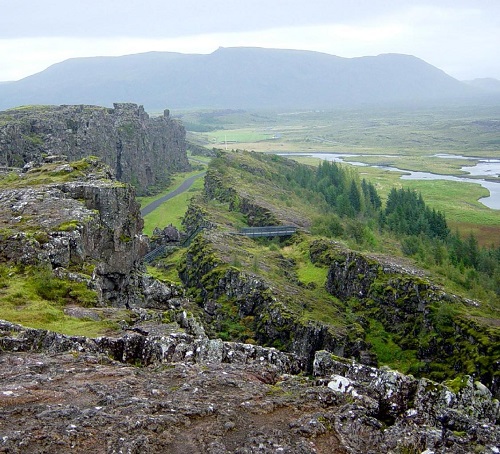
And maybe it was walking around at the site called Thingvellir (Þingvellir) on a foggy late afternoon in August that started teaching me about perspective. It was here that Iceland’s general assembly, the Alþing, first met in about 930 AD, on land that is situated at the boundaries of tectonic plates, a fissure zone that runs through Iceland itself. I walked about a mile from the small hotel and looked back across the valley as a bit of Sun emerged and a rainbow arced across the landscape. It was as if a Viking past reached all the way into the present day, and that day was itself the outgrowth of physical processes that came up out of the Earth’s deep core.
We carry the past with us wherever we walk but the sense of ‘deep time’ that overcame me that day is sometimes lost in the rush to complete day-to-day tasks. I think Les is right that we need to recover it as we look toward a human destiny among the stars. “Thingvellir is a place of echoes,” said a friend when I got back to Reykjavik. She was an English writer who had travelled often there and she knew what she was talking about. We must look back, far back, and then forward into a deep future, building our bridges as if our ancestors were crossing them.

Kepler-78b: Rocky World in Unusual Orbit
When I was first learning about astronomy by reading every book I could find on the subject — I spent a lot of time at the library in my youth — I was fascinated to hear stories of a planet closer to the Sun than Mercury. The French scientist Urbain Le Verrier pondered the existence of such a world in the 19th Century, wondering if it wouldn’t explain peculiarities in Mercury’s orbit. When an amateur astronomer named Edmond Modeste Lescarbault claimed he had observed a transit of such a planet in 1859, Le Verrier’s investigation satisfied him that the detection was legitimate. He went on to announce the discovery of the planet he dubbed Vulcan in Paris in 1860.
Despite a string of other observing claims later in the century, the existence of Vulcan is now discounted, although the possibility of asteroids in tight solar orbits hasn’t been ruled out. As for Mercury, it fell to Einstein to demonstrate that apparent anomalies in its orbit could be explained by his theory of General Relativity. Vulcan was an intriguing story in those days of my early astronomy reading, as I asked myself how anything could survive closer to the Sun than Mercury, and conjured up hellish landscapes dominated by a sky-swallowing star above.
But if we don’t have Vulcan in our own Solar System, it’s clear that many other systems do have planets in extraordinarily close orbits. Yesterday I listened in on the news conference describing Kepler-78b, one of the new class of ‘ultrashort period’ planets that Kepler has put into our databases. To qualify as an ultrashort period planet, the world has to orbit with a period of less than twelve hours. Defying the imagination, Kepler-78b bests even that figure, orbiting a star somewhat smaller and less massive than the Sun in a mere 8.5 hours.
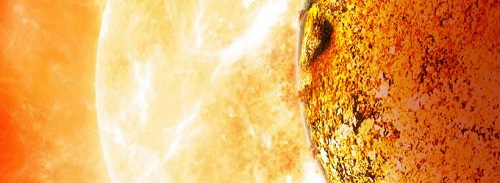
Image: Kepler-78b is a planet that shouldn’t exist. This scorching lava world, shown here in an artist’s conception, circles its star every eight and a half hours at a distance of less than 1.6 million kilometers. According to current theories of planet formation, it couldn’t have formed so close to its star, nor could it have moved there. Credit: David A. Aguilar (CfA).
Dimitar Sasselov (Harvard-Smithsonian Center for Astrophysics) told the audience that we had now found about a dozen objects orbiting various stars with periods of between three and ten hours, creating serious questions about how such planets form and survive. It’s even conceivable, said Sasselov, that Kepler-78b is the core of a former gas giant. Amidst the questions, what we do know is that its radius is about 1.2 times that of Earth and its mass 1.7 times Earth’s. With both size and mass measured, it’s possible to calculate the density, and that figure works out to 5 grams per cubic centimeter, which is a density much like our planet’s.
Kepler-78b, then, is most likely made of rock and iron. The work to demonstrate this points to the synergy between two kinds of observation and also relies on a dual investigation that produced confirming results. The planet was first observed by Kepler using the transit method, in which a planet moves in front of its star as seen from Earth and thus creates a dip in its lightcurve. Andrew Howard and team at the University of Hawaii at Manoa then used the Keck ten-meter instrument with the HIRES spectrograph to measure the star’s radial velocity, thus allowing the determination of the planet’s mass. The density reading follows from the size and mass.
Howard told the news conference that thirty hours of observations over eight nights went into the Keck work, which was a difficult measurement because the star is young and has many starspots. With an orbital period this short, the team was able to observe an entire orbit in a single night, however, and the starspot ‘noise’ could be filtered out. At the same time, Francesco Pepe (University of Geneva), using data from the HARPS-North spectrograph in the Canary Islands, was leading a companion study that verified the Keck team’s radial velocity observations. “The gold standard in science is having your findings reproduced by other researchers,” said Howard. “In this case, we did not have to wait for this to happen.”
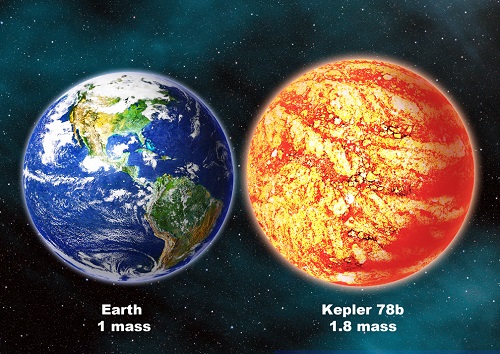
Image: This illustration compares our Earth with the newly confirmed lava planet Kepler-78b. Kepler-78b is about 20 percent larger than Earth, with a diameter of 9,200 miles, and weighs roughly 1.8 times as much as Earth. Credit: David A. Aguilar (CfA).
So we have an Earth-sized planet with Earth-like density in an orbit that remains a mystery. The star Kepler-78b orbits was larger than it is now when the planetary system was forming. “[The planet] couldn’t have formed in place because you can’t form a planet inside a star,” said Sasselov. “It couldn’t have formed further out and migrated inward, because it would have migrated all the way into the star. This planet is an enigma.” It is also a world that will eventually be torn apart by gravitational forces as it is drawn inexorably closer to the star, although according to this CfA news release, that won’t happen for another three billion years.
With temperatures as high as 3100 K on the surface, Kepler-78b is some 40 times closer to its star than Mercury is to the Sun, making my musings about Vulcan’s sky seem relatively tame. The papers are Howard et al., “A rocky composition for an Earth-sized exoplanet,” published online in Nature 30 October 2013 (abstract), and Pepe et al., “An Earth-sized planet with an Earth-like density,” published online in Nature 30 October 2013 (abstract).


